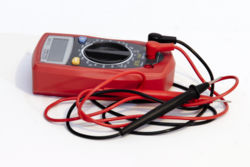Ohm
2007 Schools Wikipedia Selection. Related subjects: Electricity and Electronics
The ohm (symbol: Ω) is the SI unit of electrical impedance or, in the direct current case, electrical resistance, named after Georg Ohm.
Definition
An ohm is the electrical resistance offered by a current-carrying element that produces a voltage drop of one volt when a current of one ampere is flowing through it.
Explanation
By definition from Ohm's Law, a device has a resistance of one ohm if a voltage of one volt causes a current of one ampere to flow (R = V/I). Alternatively and equivalently, a device that dissipates one watt of power with one ampere of current flowing through it has a resistance of one ohm (R = P / I 2).
Since 1990, the ohm has been maintained internationally using the quantum Hall effect, where a conventional value is used for the ' von-Klitzing constant', fixed by the 18th General Conference on Weights and Measures as R{K-90} = 25812.807 Ω.
The complex quantity impedance is a generalisation of resistance. Its real part is resistance and its imaginary part is reactance. Impedance, resistance and reactance all have units of ohms.
The symbol for the ohm is the Greek capital letter omega (Ω). If the Greek letter cannot be used, the word ohm is used instead. The various guides for the use of the International System of Units do not explicitly forbid the elision of the final "o" of some SI prefixes, although there is nothing in them to suggest that it is allowable, either. As a result, one is just about as likely to see "kilohm", "kiloohm" and even "kilo-ohm", and the same holds true for hecto-, micro-, nano-, pico-, femto-, atto-, zepto-, and yocto-. The only other SI unit to suffer from this kind of orthographic uncertainty is the ampere. In the particular case of the ohm, one even sees the "a" prefixes lose that vowel: hence megohm and gigohm. Higher prefixes are rarely used with ohm. In the other direction, milliohms (or millohms) are seen where the resistance of cables, etc., are measured.
Units of ohms, kilohms (103 Ω) and megohms (106 Ω) are used in electronic design documentation. On schematic diagrams and parts lists kilohms are abbreviated "K" and megohms are abbreviated "M". Thus, 33 kilohms would be rendered as 33K, and 5.1 megohms would be 5.1M. Another commonly used convention is that the multiplier is used to replace the decimal point, so that 5.1 megohms can also be represented as 5M1. This convention is used because a decimal point can be difficult to see in small or cluttered print. Values less than 1K are rendered either (a) without any symbol, or (b) with an "R", following the number; so 680 ohms can be shown as 680 or 680R. Resistors are usually identified by a reference designator, R, and a cardinal number, e.g., R12.
Conversions
A measurement in ohms is the reciprocal of a measurement in siemens, the SI unit of electrical conductance. Note that 'siemens' is both singular and plural. The non-SI unit, the mho (simply put, ohm written backwards), is equivalent to siemens but is mostly obsolete and rarely used.



